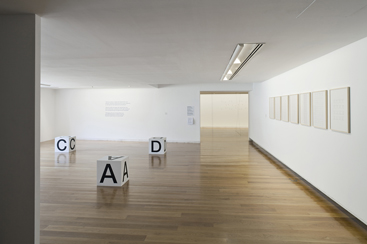
Born in 1937 in San Sebastian (ES)
Lives and works in Paris (FR)

1987
Installation.
Dimensions variables
Year of Purchase: 2013
Since the late 1960s, Esther Ferrer has been performing simple, ordinary actions devoid of any theatricality. Insisting on the importance of presence, as well as of neutrality, she obeys a minimalism based on what she calls “the strictness of the absurd”: one of her early performances consisted in being seated before the audience and doing nothing except looking. Even though she had initially considered installations resulting from her actions as cumbersome corpses, the artist concedes today that they have a life of their own. “I like to say that in performance there is primarily action, while in installation there is contemplaction, but in both, there is situaction (in-situ-action).”1 This is how even before doing anything, Parcourir un carré dans toutes les formes appeared in the form of action plans. Scores, schematics, audio instructions, and video demonstrations were laid out for the audience invited to carry out the performance by themselves. Soliciting free interpretation rather than servile exhaustion of all possible pathways, the various “user’s manuals” are far from being prescriptive.
Let there be a square marked on the ground by four cubes stamped with letters A, B, C, and D. Let there be a body X — the artist’s or a visitor’s body — whose rectilinear displacement will connect the vertices ABCD along the sides or along the diagonals, walking forward or backward. Imprecise enough to authorize eccentric approaches, these indications invite the visitor to devise a unique passage. The idea of the work goes back to the late 1970s, when Esther Ferrer became interested in primary numbers, that is numbers divisible only by one and themselves. A biographical detail: the artist comes from a large family and has a twin sister, which could explain her work with sets, sequences, and series and her taste for the multiple and for the singular.
In Ferrer’s work, the singularity of the path has less to do with Rousseau’s The Reveries of the Solitary Walker than with anonymous, universal wandering. Justified in the past as unfettered drift or random roaming, walking becomes here a peripatetic negotiation of constraints. The geometric frame of Parcourir un carré empties the body of all psychology for the sake of “physical reasoning” where “combinatory vertigo,” 2 “a theatre doomed to interminable cycling through possible formulas.” 3 The artist must have chosen the square for its banal character. Before her, others have organized more idle, quasi-penitent choreographies: Bruce Nauman step-dancing to the rhythm of the metronome on the perimeter of a square (Square Dance_, 1967–68) or Samuel Beckett moving four human pawns within a square (_Arena Quad I+II, 1981). Ferrer, however, who loves saying that “walking makes the path,” does not find the square at all alienating. It’s not a question of “going round in circles,” but rather of trying all possible moves.
Hélène Meisel~
1 Esther Ferrer, “Install-action”, Inter Art Actuel (Québec), No. 74 (1999).
2 Thierry Davila, “Errare humanum est (remarques sur quelques marcheurs de la fin du XXe siècle)”, in Un siècle d’arpenteurs, les figures de la marche. Exhibition catalogue (Paris: Réunion des musées nationaux, 2000), p. 290
3 Ibid.